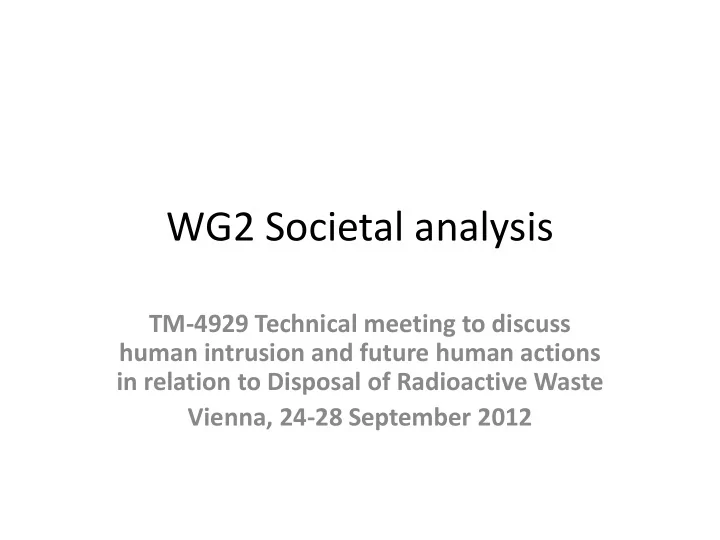

WG2 Societal analysis TM-4929 Technical meeting to discuss human intrusion and future human actions in relation to Disposal of Radioactive Waste Vienna, 24-28 September 2012
Participants in WG 2 Andrey Guskov, Russian Federation Attila Baksay, Hungary Cecile Castel, France Eva Andersson, Sweden Juergen Wollrath, Germany Julie Mecke, Canada Maria Palattao, Philippines Mette Nilsen Norway Michael Tichauer, France Nataliya Rybalka, Ukraine Sucipta Sucipta, Indonesia
Background -rationale Future human actions depend on many factors including societal ones. Societal aspects are a combination of: – the lifestyle, motivations, and cultural, moral and ethical values of the people (individuals and group), – the evolution of knowledge and technology – the institutions, whether they are operators, regulators, local, national or international organizations, or any other stakeholders that might arise in the future.
The Objectives of WG 2 is to • To share and exchange information and communicate good practice on: – How societal aspects drive the generation of FHA scenarios eventually used in the safety case – How the use of FHA scenarios helps build confidence in the overall safety of the disposal facility (including derivation of WAC) at all phases of its life cycle – How to preserve knowledge throughout the life cycle of the disposal facility – How to involve and communicate with stakeheolders in the development and use of the safety case (aspects related to FHA)
Objective that WG 2 has discussed but that could moved to an integrating group • Consider how scenarios regarding FHA are used in the safety case and the development of WAC – explore the position and role of HI/FHA scenarios among other scenarios used in the safety case: it should be made clear how this kind of scenario impacts the demonstration that the disposal system is safe through the lifecycle of the facility; – address the use of HI/FHA scenarios regarding the evaluation of the robustness of the disposal system; – explore the approach for assessing the consequences of HI/FHA scenarios, regarding impacted targets; – address the impact of the interpretation of the results of HI/FHA scenarios on the different parts of the safety case. • Common methodology – according to ISAM methodology, most scenarios used in the safety case are derived from the FEP screening process. In the context of HI/FHA scenarios, the relevance of such a methodology should be explored. – The issue of the relevance of detailed HI/FHA scenarios should also be explored in light of highly stylized scenarios that focus on actual impacts on the safety functions. – The same approach should be adapted to the actual impacts on the performance of the SSCs. Shall the methodology of safety assessment of HI/FHA scenarios rely on the features of such scenarios (a description of the scenarios that details the events that would occur) or on the actual assumed impacts on the performance of the SSCs of the disposal facility ?
Scope- Topics we want to cover • Level of development • State of knowledge – what distinguish inavdert from advert • What would make records, institutional knowledge more effective – international archives? monitoring? • Time frame when the assessment is applicable? • What types of passive controls can be effective in preventing inadvertent intrusion • Inclusion of probabilities/likehoods? • Public perception of intrusion – over cautious, conservatisms • Time frame when the assessment is applicable? • Consider how scenarios regarding FHA are used in the process of siting, designing and developing WAC • Common methodology
Work so far- Divided topics into 3 sub working groups Group 1 - Attila, Cecile, Maria, – Level of development, – State of knowledge – what distinguish inavdert from advert, – What would make records, institutional knowledge more effective – Time frame Group 2 - Mette, Julie, Sucipta, Juergen – What types of passive controls can be effective – Inclusion of probabilities/likehoods? – Public perception of intrusion – over cautious, conservatisms – Time frame when the assessment is applicable? Group 3 – Michael, Andrey, Nataliya – Consider how scenarios regarding FHA are used in the process of siting, designing and developing WAC – Common methodology
Outcome • Notes from meeting • Terms of reference – Rationale – Objectives – Scope – Identified couplings to other projects/workgroups – outcome – Contributions of participants • A report that compile information on how different aspects societal aspects may be included in safety cases. – Background, objectives, conclusion from societal group. – Consensus between member states should be clearly identified where applicable, and areas where differences have been identified should be outlined.
Couplings to other workgroups The workgroup societal analysis has overlaps with the other workgroups and topics regarding safety cases. Cooperation and/or information exchange are wanted with the following projects: • GEOSAF 2 – regarding our topic to considering how scenarios regarding future human actions are integrated into the safety case at every step of life cycle of the disposal facility (siting, designing, construction etc) • PRISM – regarding our topic to considering how scenarios regarding future human actions are integrated into the safety case at every step of life cycle of the disposal facility (siting, designing, construction etc) • IAEA initiative on Communication with stakeholders • IAEA siting documents • Other international stakeholder consultation groups, e.g. NEA FSC • Information preservation groups – Are there groups/projects working with information preservation that could be contacted to discuss assumptions regarding how long knowledge of repository can be assumed, how to relate to archives etc.
Work plan • Directly after this meeting – Finalizing Notes from this meeting and circulate between work group members for comments – Finalize our contribution to Terms of references and circulate between group members for comments – Circulate draft of chapter for possibility to comment on draft
Work plan • Before second plenary – Circulate draft among work group members – Identify and contacts sources of information (people or organizations that could be consulted) – Identify additional topics that should be covered – Collect examples that could be used in the description
Recommend
More recommend